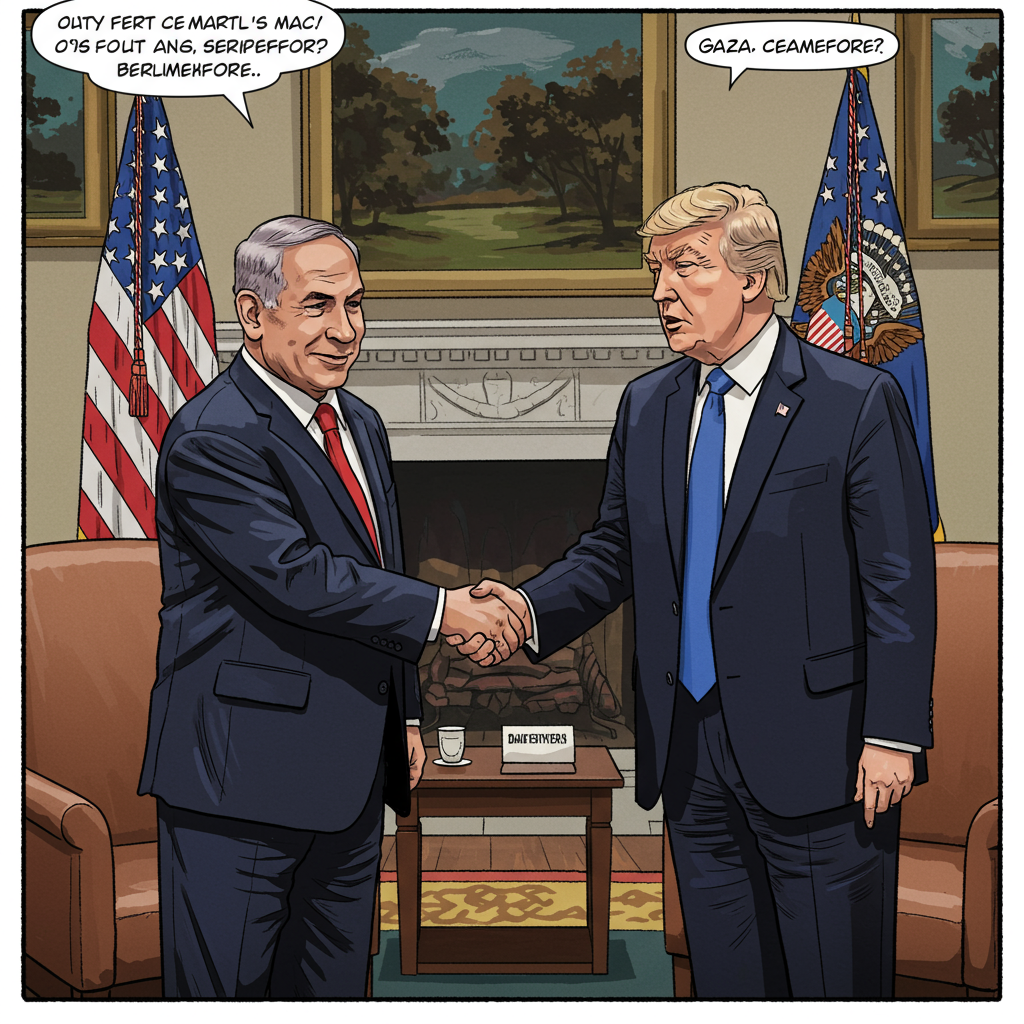Israeli Prime Minister Benjamin Netanyahu heads to Washington this week, voicing confidence that crucial discussions with U.S. President Donald Trump could significantly advance efforts toward a Gaza Strip hostage release and ceasefire agreement. This pivotal meeting comes as complex, indirect negotiations resume in Qatar and mounting domestic pressure weighs on Netanyahu’s government. The Prime Minister’s belief underscores the perceived importance of American presidential engagement in navigating the challenging path towards de-escalation in the protracted conflict.
High-Stakes Diplomacy in Washington
Prime Minister Netanyahu is scheduled to meet with President Trump on Monday, marking his third visit to the White House since Trump’s reported return to power approximately six months ago. Speaking before his departure, Netanyahu expressed a clear expectation that his dialogue with the American leader would “certainly help advance these results” – specifically, securing the release of hostages held by militants in Gaza and establishing a ceasefire. This diplomatic push highlights the enduring strategic partnership between Israel and the United States, particularly under Trump’s presidency.
The timing of the visit coincides with renewed diplomatic efforts to broker a temporary end to hostilities in Gaza. As Netanyahu prepares for his Washington talks, an Israeli negotiating team is actively participating in ceasefire discussions currently underway in the Gulf nation of Qatar.
Navigating Complex Ceasefire Negotiations
Israeli negotiators in Doha are operating under specific guidelines, tasked with achieving an agreement. However, Prime Minister Netanyahu emphasized that these instructions are strictly aimed at securing a ceasefire agreement only “under conditions that Israel has accepted.” This stipulation points to the inherent difficulties in bridging the gap between the demands of both sides and finding mutually agreeable terms. The presence of a delegation in Qatar, despite stated disagreements over proposal details, signals a continued commitment to the negotiation process, even amidst significant obstacles.
Significant public pressure within Israel is also a key factor influencing the political landscape. Calls for a permanent ceasefire and the return of hostages are growing louder, creating a complex environment for Netanyahu, whose right-wing coalition includes members with differing views on ending the conflict. While some hardline factions oppose a ceasefire, others, like Foreign Minister Gideon Saar, have publicly expressed support for reaching a deal. This internal debate reflects the deep societal impact of the ongoing war.
The Proposed Path to a Temporary Truce
Details of a recent U.S.-backed ceasefire proposal, shared with media outlets by sources familiar with the negotiations, shed light on the potential framework being considered. This proposal reportedly outlines a 60-day period of calm intended to halt military operations. Under this temporary arrangement, the Palestinian militant group Hamas would reportedly release a specific number of hostages – the proposal document reportedly mentions 10 living and 18 deceased captives. In exchange for these releases, Israel would reportedly free an agreed-upon number of Palestinian prisoners held in Israeli jails, though the precise figures for this exchange were not yet finalized in the reported proposal.
A crucial element of this plan involves a shift in Israeli military posture within Gaza. The proposal reportedly requires Israeli forces to withdraw to a designated buffer zone positioned along Gaza’s borders with both Israel and Egypt. Alongside troop movements and exchanges, the framework also mandates a significant increase in humanitarian aid deliveries into the devastated enclave. This assistance would reportedly be distributed by established international bodies, including UN agencies and the Palestinian Red Crescent.
Stumbling Blocks Remain
Despite Hamas reportedly responding to the U.S.-backed proposal in a “positive spirit,” significant hurdles persist. Days after President Trump indicated Israel had agreed “to the necessary conditions to finalise” a 60-day truce, Netanyahu’s office issued a statement indicating that changes sought by Hamas to the proposal were deemed “not acceptable to Israel.” This suggests a fundamental disagreement over specific terms or conditions, despite the general positive reception from Hamas. However, the decision for the Israeli delegation to continue talks in Qatar, even with these stated disagreements, underscores the delicate balance between rejecting unacceptable terms and maintaining a channel for negotiation.
Another core point of contention remains Israel’s consistent demand that Hamas be disarmed. The militant group has reportedly refused to even discuss this condition as part of ceasefire negotiations. Furthermore, reports from a Palestinian official allied with Hamas highlighted remaining concerns regarding the specifics of humanitarian aid delivery, the operation of the crucial Rafah crossing into Egypt, and clarity surrounding a definitive timetable for the withdrawal of Israeli troops from Gaza. These points illustrate the complex details that still require resolution before any agreement can be finalized and implemented on the ground.
Broader Regional Agenda: Iran and Peace Efforts
Beyond the immediate focus on Gaza, Prime Minister Netanyahu indicated that his upcoming discussions with President Trump would also encompass wider regional security challenges. A key topic is expected to be building upon the outcome of the recent 12-day air conflict with Iran that occurred last month. Netanyahu stated his intention to work with Trump to further ensure that Tehran never develops a nuclear weapon. This objective remains a high priority for Israel and a shared concern with the United States.
Netanyahu also suggested that recent developments across the Middle East have potentially created new opportunities to expand regional peace initiatives. This could refer to advancing normalization agreements with Arab nations, building on previous accords, or exploring new diplomatic avenues to foster stability and cooperation in the volatile region. The meeting in Washington provides a platform to align strategies on these broader geopolitical goals.
Domestic Pressure and the Human Cost
Within Israel, public sentiment is increasingly focused on the urgent need to end the conflict in Gaza and secure the return of remaining hostages. On Saturday evening, crowds gathered in Tel Aviv near the defense ministry headquarters, holding Israeli flags and posters featuring photos of the captives. These demonstrations reflect the deep emotional toll the war has taken on Israeli society and serve as a visible expression of the pressure on the government to prioritize a deal that brings the hostages home.
The current escalation of the decades-old Israeli-Palestinian conflict began on October 7, 2023, with a devastating Hamas attack on southern Israel. That assault resulted in the deaths of approximately 1,200 people and the capture of 251 hostages, according to Israeli tallies. Israel’s subsequent large-scale military campaign in the Gaza Strip has led to a catastrophic humanitarian situation. According to Gaza’s health ministry, the conflict has killed over 57,000 Palestinians. The assault has also displaced the vast majority of Gaza’s population, primarily within the territory, caused a severe hunger crisis, and left wide areas in ruins. Of the initial 251 hostages, around 50 are believed to still be held in Gaza, with current estimates suggesting approximately 20 are alive and 30 deceased. While many hostages were freed through diplomatic negotiations, the Israeli military has also recovered some.
Frequently Asked Questions
Why does Prime Minister Netanyahu believe President Trump can help with the Gaza ceasefire?
Prime Minister Netanyahu stated before his flight to Washington that he believes his scheduled discussion with U.S. President Donald Trump can “certainly help advance” a Gaza ceasefire and hostage release deal. This expectation is likely based on Trump’s previous involvement in Middle East diplomacy, including reports that the latest US-backed proposal includes Trump’s personal guarantee of Israel’s adherence to halting military operations and his plan to personally announce the agreement. Netanyahu seems to view Trump’s direct engagement as potentially crucial for overcoming current obstacles and moving talks forward on terms acceptable to Israel.
Where are the direct talks between Israeli negotiators and Hamas happening?
The main negotiations attempting to secure a Gaza ceasefire and hostage release are currently taking place indirectly in Qatar. An Israeli delegation resumed talks there on Sunday, the day before Prime Minister Netanyahu was due to meet President Trump in Washington. While Hamas is represented, the talks are described as indirect, meaning negotiators from both sides are typically in separate rooms or locations, with mediators facilitating communication and conveying proposals back and forth. Qatar has played a key mediating role alongside the United States and Egypt.
What are the key elements of the US-backed ceasefire proposal being discussed?
The US-backed proposal reportedly outlines a 60-day truce period. During this time, Hamas would release a set number of hostages (reportedly 10 living and 18 deceased hostages mentioned in one document version) in exchange for Palestinian prisoners held by Israel. The plan also includes Israel withdrawing forces to a buffer zone along Gaza’s borders and significantly increasing the flow of humanitarian aid into the enclave, distributed by international agencies. While the proposal does not guarantee a permanent end to the war, it reportedly allows for negotiations on a lasting ceasefire to occur during the 60-day truce period.
In summary, Prime Minister Netanyahu’s trip to meet President Trump comes at a critical juncture for Gaza ceasefire and hostage release talks. While negotiators are actively engaged in Qatar, significant disagreements persist, particularly regarding Hamas’s proposed changes to the latest proposal and Israel’s demands. Netanyahu’s belief in Trump’s potential to break the deadlock highlights the vital role of American leadership in the region. The meeting also provides an opportunity to address broader strategic concerns, including Iran’s nuclear ambitions and the potential for expanding regional peace initiatives, all against the backdrop of intense domestic pressure and the devastating human cost of the ongoing conflict in Gaza.




